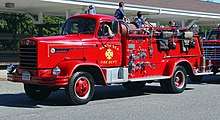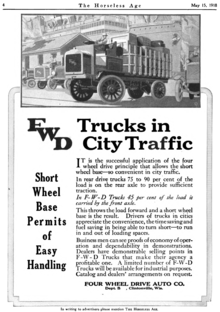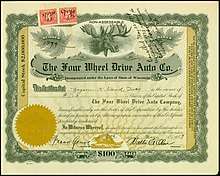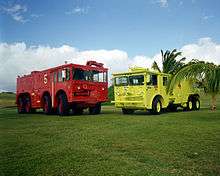Four Wheel Drive
 1958 FWD fire engine | |
| Industry | Automotive |
|---|---|
| Founded | 1909 in Clintonville, Wisconsin |
| Founders | Otto Zachow, William Besserdich |
The Four Wheel Drive Auto Company, more often known as Four Wheel Drive (FWD), was a pioneering American company that developed and produced all-wheel drive vehicles. It was founded in 1909 in Clintonville, Wisconsin, as the Badger Four-Wheel Drive Auto Company by Otto Zachow and William Besserdich.[1] The first production facility was built in 1911 and was designed by architect Wallace W. DeLong of Appleton Wisconsin.[2]
History


Zachow and Besserdich developed and built the first successful four-wheel drive (4x4) car, the "Battleship", in 1908. Its success led to the founding of the company. "Badger" was dropped from the name in 1910.[1] Besserdich and Zachow's patented full time four wheel drive system combined a lockable center differential with double-Y constant velocity universal joints for steering. In modern terms the Battleship would be considered All Wheel Drive as all FWD products featured full-time four wheel drive with a lockable center differential.
The success of the four-wheel drive in early military tests prompted the company to switch from cars to trucks. In 1916 the U.S. Army ordered 147 Model B three ton trucks for the Pancho Villa Expedition.[3] The U.S. Army ordered 15,000 FWD Model B three ton trucks as the "Truck, 3 ton, Model 1917" during the World War I with over 14,000 actually delivered; additional orders came from the United Kingdom and Russia.[4] In two world wars, U.S. and allied armies depended on such four-wheel drive vehicles.[5] Numerous FWD model B trucks, both military and civilian, survive in working condition; A Model 1917 U.S. Army truck in working condition is on display at the Fort MacArthur Military Museum, San Pedro, Los Angeles, California.
Early FWD vehicles were made with a track width of 4 feet 8 1⁄2 inches (1.435 m) so they could quickly be used on a standard gauge railway line merely by changing the wheels.
The FWD Model B was produced under license by four additional manufacturers during World War I: Peerless Motor Company, Cleveland, Ohio; Kissel Motor Car Company, Hartford, Wisconsin; Premier Motor Corporation, Indianapolis, Indiana; and Mitchell Motor Car Company, Racine, Wisconsin.[6]
A Canadian subsidiary was set up in conjunction with Dominion Truck of Kitchener, Ontario by 1919.
A British subsidiary was set up at Slough in 1921. In 1926, the British FWD, also known as the Quad, was produced with a larger 70 bhp engine.
A relationship with premier race car constructor Harry Miller resulted in the Four Wheel Drive Miller that competed successfully at the Indianapolis 500 in 1931 and later. This car was intended to demonstrate that the advantages FWD's lockable center differential were not limited to off-road driving. One example survives and has competed in premier vintage race car meets such as the Goodwood Festival of Speed. "The Last Great Miller" by Griffith Borgeson gives a complete history of this landmark car.
In 1932, AEC took a controlling interest in the British company and began to use more standard AEC components in the Slough-built vehicles. To distinguish these from imported U.S. FWD vehicles, they were marketed under the name Hardy. Production ceased about 1936, but AEC exploited its experience with all-wheel drive in its Second World War Matador (4x4) and Marshall (6x6) vehicles.

In 1958, the company's name was changed to FWD Corporation.
In 1963, FWD acquired Seagrave Fire Apparatus who then moved from their old location in Columbus, Ohio, to their current location at FWD in Clintonville, Wisconsin. Many tower ladders in the 1990s using Seagrave chassis were branded as FWD. They used Baker Aerialscopes for the boom which FWD had also acquired over the years along with Almonte Fire Trucks.
Randolph Lenz, Chairman of FWD's parent company, Corsta Corp., became embroiled in a Federal Deposit Insurance Corporation suit and in 2003 all assets of FWD. FWD Corporation, Seagrave, Baker Aerialscope, and Almonte Fire Trucks were sold to an investment group headed by former American LaFrance executive James Hebe. Today, the Seagrave Fire Apparatus group is a flagship company of ELB Capital Management.
See also
| Wikimedia Commons has media related to FWD vehicles. |
- G-numbers, (SNL G174)
- Luella Bates. first licensed woman truck driver employed by the Four Wheel Drive Auto Co. 1918-1922.
References
- 1 2 Borth, Christy. Masters of Mass Production. Indianapolis, Ind.: Bobbs-Merrill Co., 1945, pp. 210-14.
- ↑ "Machinery and Tool Manufacture". Industrial World. 45 (1): 299. March 6, 1911 – via Google Books.
- ↑ Karolevitz, Robert (1967). This Was Trucking: A Pictorial History of the First Quarter Century of the Trucking Industry. Seattle: Superior Publishing Company. p. 100. ISBN 0-87564-524-0.
- ↑ "FWD Model B". Military Factory. Military Factory. Retrieved March 4, 2018.
- ↑ Borth, Christy. Masters of Mass Production. Indianapolis, Ind.: Bobbs-Merrill Co., 1945, pp. 212-14.
- ↑ Karolevitz, p.100
External links
- http://www.eliason-snowmobile.com/ Early product
- https://archive.org/details/americasmunitio01deptgoog Early vehicles
- http://www.landships.freeservers.com/new_pages/fwd_truck_info.htm Liberty truck
- http://www.mace-b.com/38TMW/Missiles/MM-1.htm Teracruzer